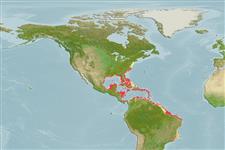Common names from other countries
Environment: milieu / climate zone / depth range / distribution range
Écologie
marin récifal; non migrateur; profondeur 2 - 60 m (Ref. 9626). Tropical; 22°C - 28°C; 44°N - 23°S, 98°W - 34°W
Western Atlantic: New England, USA to the vicinity of Rio de Janeiro, Brazil, including the Gulf of Mexico and the Caribbean (Ref. 26938).
Length at first maturity / Taille / Poids / Âge
Maturity: Lm 22.6 range ? - ? cm
Max length : 60.0 cm TL mâle / non sexé; (Ref. 3797); common length : 45.0 cm TL mâle / non sexé; (Ref. 3797); poids max. publié: 1.8 kg (Ref. 40637)
Épines dorsales (Total) : 9; Rayons mous dorsaux (Total) : 31 - 33; Épines anales: 3; Rayons mous anaux: 23 - 25. Pale gray around mouth, and pale gray margin on caudal fin. Inside of pectoral fin yellow (Ref. 26938). Juveniles are black with two light yellow bars on body and three on head; caudal fin yellow with a vertically elongate, nearly rectangular or hemispherical black spot in middle (Ref. 13442).
Maximum depth from Ref. 126840. Common in coral reefs, usually solitary, occasionally in pairs. Juveniles are part-time cleaners. Feed mainly on sponges, but also takes tunicates, algae, zoantharians, gorgonians, hydroids, bryozoans, and seagrasses. Oviparous (Ref. 240), monogamous (Ref. 52884). Flesh reported to be of excellent quality (Ref. 3797); marketed fresh and salted (Ref. 5217). Friendly toward divers (Ref. 9710). Have been reared in captivity (Ref. 35419).
Life cycle and mating behavior
Maturities | Reproduction | Spawnings | Egg(s) | Fecundities | Larves
Monogamous mating is observed as both facultative and social (Ref. 52884).
Allen, G.R., 1985. Butterfly and angelfishes of the world. Vol. 2. 3rd edit. in English. Mergus Publishers, Melle, Germany. (Ref. 4858)
Statut dans la liste rouge de l'IUCN (Ref. 130435)
CITES (Ref. 128078)
Not Evaluated
Menace pour l'homme
Reports of ciguatera poisoning (Ref. 30303)
Utilisations par l'homme
Pêcheries: intérêt commercial mineur; Aquarium: Commercial
Outils
Articles particuliers
Télécharger en XML
Sources Internet
Estimates based on models
Preferred temperature (Ref.
115969): 23.8 - 28.1, mean 27.3 (based on 849 cells).
Phylogenetic diversity index (Ref.
82804): PD
50 = 0.5001 [Uniqueness, from 0.5 = low to 2.0 = high].
Bayesian length-weight: a=0.03236 (0.01644 - 0.06368), b=2.90 (2.73 - 3.07), in cm Total Length, based on LWR estimates for this species & Genus-body shape (Ref.
93245).
Niveau trophique (Ref.
69278): 3.2 ±0.1 se; based on diet studies.
Résilience (Ref.
120179): Très faible, temps minimum de doublement de population supérieur à 14 ans (Preliminary K or Fecundity.).
Fishing Vulnerability (Ref.
59153): Moderate vulnerability (44 of 100).
